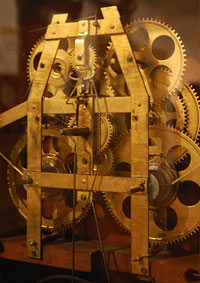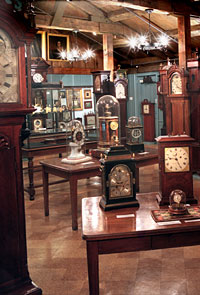Time is the Essence: American Clock & Watch Museum
 Eight-day movement created from cold-rolled brass by C. & L.C. Ives of Bristol, CT from the 1830s.
Eight-day movement created from cold-rolled brass by C. & L.C. Ives of Bristol, CT from the 1830s.Photo courtesy of Dan Dziedzic, American Clock & Watch Museum
Few people ever think about the daily passing of time. But in Bristol, Connecticut the American Clock & Watch Museum ponders time quite literally. Housed in an 1801 residence are over 2,500 clocks watches, with roughly 1,500 are on display. Some of the timepieces date back to 1595.
Donald Muller is the executive director of the museum and explains how brass has played an integral part of most of the timepieces in America. Early timekeeping devices were copper and brass sundials, and the earliest clocks were made of brass and iron.
"Clock parts were molded from heated brass," says Muller. "They would then pour the liquid into molds, then hammer, file and fit the pieces together." This was time consuming and expensive, so much so that early clocks and watches were exclusively for the wealthy. "These were skilled metalworkers, who also worked with silver and other metals. But the clocks were the things they signed," Muller says of the pride associated with being a clockmaker, who routinely churned out 10 to 15 clocks per year. Another added expense was importing copper from England and Wales, since there were few copper mines in the region. Clocks were a status symbol and they gave clockmakers an artistic expression.
"They intricately engraved the brass dials, since they showed," he explains. "The brass movements were technically complicated, but no one saw them." By the end of the 18th Century, excessive prices forced clockmakers to experiment, and between 1810 and 1840, wood clocks dominated the market. "Eli Terry harnessed water power to run machinery and he standardized equipment, creating interchangeable parts," Muller says. This enabled him to mass produce clocks using unskilled labor. "Terry produced 4,000 cocks in three years, which is the quantum leap forward. In a sense, he put the brass movement industry almost completely out of business."
But brass would soon reclaim its rightful position as the metal of choice. Benedict and Burnham Brass Company introduced the first rolled brass machine in 1824. "It took a while for that to catch on," Muller says. "When they started rolling brass, clockmakers could stamp out the parts. It was very uniform, and they could produce in large quantities." In 1838 the first inexpensive rolled brass clock hit the market which was a resounding success. With the advent of water powered and then steam powered machinery, brass once again became an inexpensive metal to use. "Brass came back with a vengeance, effectively putting the wood out of business," Muller states. With mass production, prices dropped so that many people could now afford a wristwatch, pocket watch or clock. With the industrial revolution, America moved from an agricultural society, one governed by the rising and the setting of the sun, to a mechanized society. "Workers needed to be places at certain times and the idea of individuals keeping their own time became important," Muller says.
 The Barnes Wing at The American Clock & Watch Museum containing our collection of brass movement tallcase clocks.
The Barnes Wing at The American Clock & Watch Museum containing our collection of brass movement tallcase clocks. Photo courtesy of Dan Dziedzic American Clock & Watch Museum
But another seminal event would change brass clocks yet again. "During World War II, the government shut down clock manufacturing altogether, and they went into production for the war effort," Muller states. He cites the Ingram Company as one example. "They made fuses for artillery shells which were essentially clock mechanisms designed to explode after a certain number of seconds," Muller said. "They were, in effect, small cheaply made wristwatches." But the electric clock soon vanquished mechanical clocks and brass was no longer a crucial element to telling time.
In its day, Connecticut was the time keeping center of America. "We've discerned 280 different clock manufactures in Bristol over the years," Muller says. "Seven major clock makers consolidated here, and 95 percent of the clocks were produced in Western Connecticut." The Museum sees a variety of tourists and schools come through their doors. Some visit for the nostalgia, remembering fondly a grandparents clock on a mantle. Others inherit a clock, one of the few important items to be passed from generation to generation, and people want to understand its history. The museum offers both permanent and rotating exhibits to provide a chronology of the American way of life. And that way is changing yet again. "The demand for wristwatches is diminishing," Muller says. "The younger generation looks at their cell phone to tell time digitally, but can't read a clock dial," he says. Yet through the years, time has been kept, in a large part by brass. That contribution to our society means we always know exactly where we are.
Resources:
Also in this Issue:
- Valentin Yotkov: Continuing the Master Craft of Repoussé
- UB Arts Sheds New Light on Reclaimed Copper
- Miel-Margarita Paredes Imaginatively Reinterprets Our World
- Time is the Essence: American Clock & Watch Museum
- Cast in Bronze: French Sculpture from Renaissance to Revolution on View at Met
